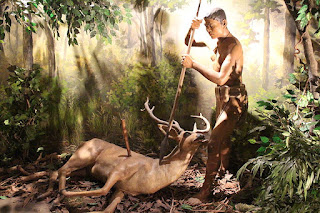 |
| Reconstruction of a hunter from the archaeological site of Ban Chiang in present-day Thailand |
For the purposes of this blog, Southeast Asia will be held to comprise the lands of Myanmar, Thailand, Laos, Vietnam, Cambodia, the Philippines, Malaysia, Singapore, Brunei, the archipelago of Indonesia and East Timor. There are strong reasons for including Taiwan and southern China within the remit of this piece, but these will be covered elsewhere I think.
 |
| Axe, seen from different angles, from Samrong Sen in present-day Cambodia |
Later Vietnamese writers of history identified a legendary dynasty beginning around 2800BC. This is extremely ancient and there is no real evidence to support this. The dynasty was referred to as the Hong Bang dynasty and was supposed to have ruled in what is now northern Vietnam, near the Red River Delta. This dynasty reigned over a kingdom that was supposedly called Van Lang. It should be noted that the history of Vietnam, while undoubtedly ancient, was also affected by a number of destructive wars fought with the Chinese, which seems to have destroyed a certain amount of records. As this dynasty is only really referred to by later writers from the 15th Century AD and there is no archaeological evidence for it, we should probably relegate this kingdom to the realms of legend. However, it would be correct to state that the Red River Delta would be important to the later history of the region.
 |
| Vase from different angles, from Samrong Sen in Cambodia |
During this period, we can be certain that wet-rice agriculture and millet farming had been introduced to areas such as Laos and northern Thailand.
In northern Vietnam the Phung Nguyen culture began to flourish. Here as well, we begin to see definite evidence of farming in a recognisable fashion. In southern Thailand the Khok Phanom Di site began to be occupied. It comprises a series of burials near habitations from the late Neolithic to the Early Bronze Age. The inhabitants of Khok Phanom Di may not have been full agriculturalists at the beginning of the settlement however, as they seem to have eaten a great deal of fish, suggesting a more hunter-gatherer lifestyle.
Around this period, the Hoabinhian stone tools begin to disappear from the archaeological record of Southeast Asia. Quite simply the older Mesolithic tools were beginning to be replaced by more sophisticated stone tools as more and more of the region became used for agriculture.
Around the century of the 1900’s BC the shell middens of Lal-lo and Gattaran, in what is now known as the Philippines, began to be used. These were situated along the Cagayan River banks, on the northern island of Luzon. The shell middens hold discarded seafood shells and other remnants of a culture. Effectively they are rubbish heaps, but archaeologically significant rubbish heaps. These people were probably Austronesian speakers but despite the existence of the middens, there is not much that can be said about this, save that these people seem to have participated in the jade trade at that time.
 |
| Reconstruction of woman painting pottery at Ban Chiang in Thailand. This style of pottery probably dates from the next millennium however |
The Cambodian site of Samrong Sen shows evidence of bronze working around this time. The fact that the lands now referred to as Cambodia have no copper deposits suggest that the copper was imported from outside the region, thus inferring some form of trade networks.
Around this time, in the area of the Red River region in what is now northern Vietnam, the Phung Nguyen culture came to an end. The Dong Dau culture took its place. These names are only archaeological designations, as the two cultures are only differentiated by different types of pottery markings.
 |
| Dong Son Vase from Vietnam, probably dates from the next millennium however |
By the ending of the period, around the century of the 1000’s BC the Dong Dau culture in Vietnam had been replaced by the Go Mun culture and the Dong Son culture. Further to the south of the Red River basin, in central and southern Vietnam, the Sa Huynh culture was beginning. Both the Sa Huynh and Dong Son are rather interesting cultures but will be dealt with in future blogs.
At the beginning of this time period in Southeast Asia agriculture was only partially adopted across the region and bronze-working, if it was known, was rather limited. By the end of the millennium agriculture had spread to nearly every part of Southeast Asia and bronze working was well known on the mainland, although it had perhaps not spread out to the island archipelagos of Indonesia and the Philippines just yet.
Related Blog Posts:
Some Southeast Asian history from 4000-2000BC
Some Southeast Asian history from 2000-1000BC
Some Southeast Asian history from 1000-500BC
No comments:
Post a Comment